The Radeon R9 280X Review: Feat. Asus & XFX - Meet The Radeon 200 Series
by Ryan Smith on October 8, 2013 12:01 AM ESTCompute
Jumping into compute, as with our synthetic benchmarks we aren’t expecting too much new here. Outside of DirectCompute GK104 is generally a poor compute GPU, which makes everything very easy for the Tahiti based 280X. At the same time compute is still a secondary function for these products, so while important the price cuts that go with the 280X are not quite as meaningful here.
As always we'll start with our DirectCompute game example, Civilization V, which uses DirectCompute to decompress textures on the fly. Civ V includes a sub-benchmark that exclusively tests the speed of their texture decompression algorithm by repeatedly decompressing the textures required for one of the game’s leader scenes. While DirectCompute is used in many games, this is one of the only games with a benchmark that can isolate the use of DirectCompute and its resulting performance.
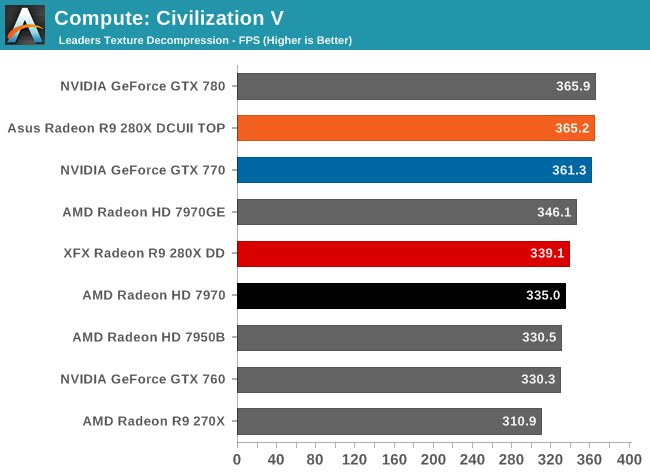
With Civilization V we’re finding that virtually every high-end GPU is running into the same bottleneck. We’ve reached the point where even GPU texture compression is CPU-bound.
Our next benchmark is LuxMark2.0, the official benchmark of SmallLuxGPU 2.0. SmallLuxGPU is an OpenCL accelerated ray tracer that is part of the larger LuxRender suite. Ray tracing has become a stronghold for GPUs in recent years as ray tracing maps well to GPU pipelines, allowing artists to render scenes much more quickly than with CPUs alone.
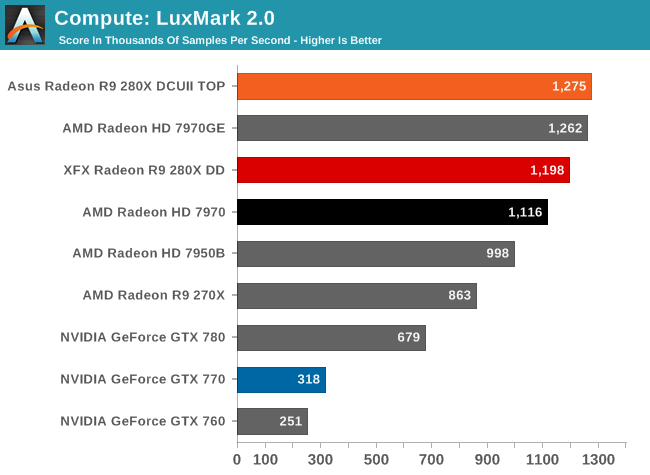
AMD simply rules the roost when it comes to LuxMark, so the only thing close to 280X here are other Tahiti parts.
Our 3rd compute benchmark is Sony Vegas Pro 12, an OpenGL and OpenCL video editing and authoring package. Vegas can use GPUs in a few different ways, the primary uses being to accelerate the video effects and compositing process itself, and in the video encoding step. With video encoding being increasingly offloaded to dedicated DSPs these days we’re focusing on the editing and compositing process, rendering to a low CPU overhead format (XDCAM EX). This specific test comes from Sony, and measures how long it takes to render a video.
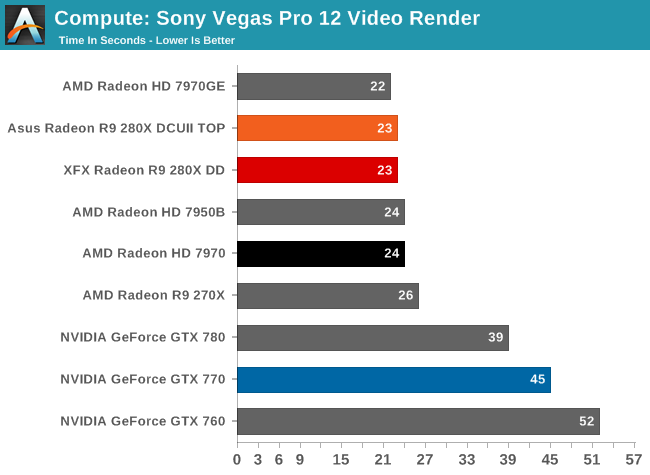
Again AMD’s strong compute performance shines through, with 280X easily topping the chart.
Our 4th benchmark set comes from CLBenchmark 1.1. CLBenchmark contains a number of subtests; we’re focusing on the most practical of them, the computer vision test and the fluid simulation test. The former being a useful proxy for computer imaging tasks where systems are required to parse images and identify features (e.g. humans), while fluid simulations are common in professional graphics work and games alike.
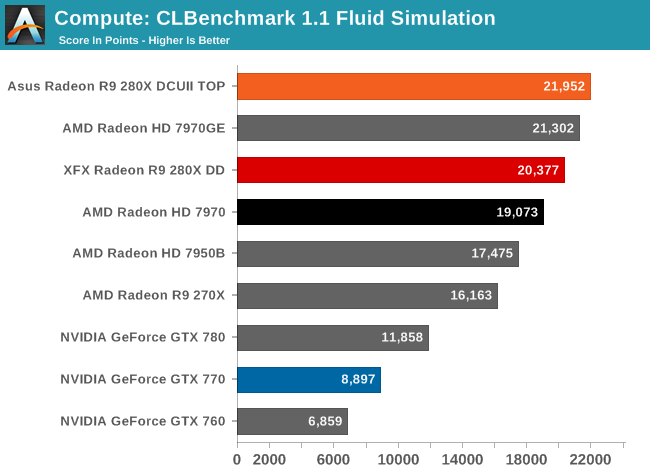
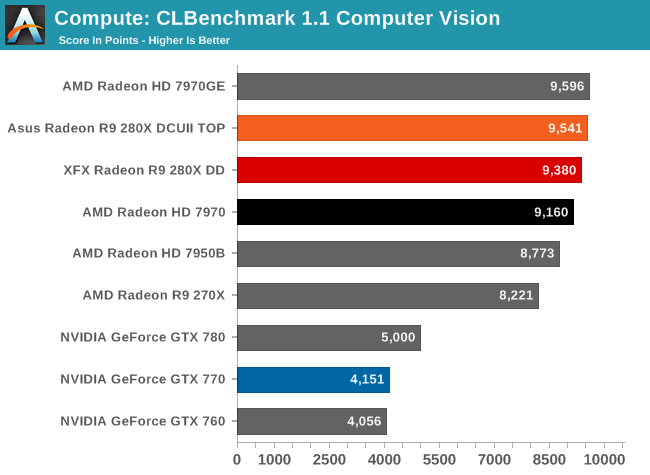
Despite the significant differences in these two workloads, in both cases 280X comes out easily on top.
Moving on, our 5th compute benchmark is FAHBench, the official Folding @ Home benchmark. Folding @ Home is the popular Stanford-backed research and distributed computing initiative that has work distributed to millions of volunteer computers over the internet, each of which is responsible for a tiny slice of a protein folding simulation. FAHBench can test both single precision and double precision floating point performance, with single precision being the most useful metric for most consumer cards due to their low double precision performance. Each precision has two modes, explicit and implicit, the difference being whether water atoms are included in the simulation, which adds quite a bit of work and overhead. This is another OpenCL test, as Folding @ Home has moved exclusively to OpenCL this year with FAHCore 17.

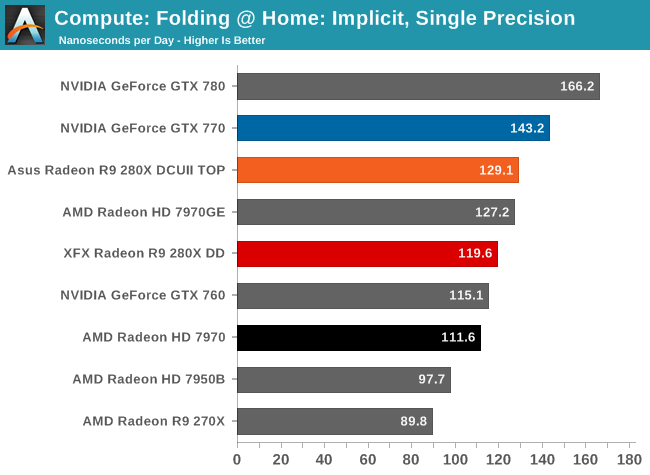

Depending on the mode and the precision, we can have wildly different results. The 280X does well in FP32 explicit, for example, but in implicit mode the 280X is now caught between the GTX 770 and GTX 760. But if we move to double precision then AMD’s native ¼ FP64 execution speed gives them a significant advantage here.
Wrapping things up, our final compute benchmark is an in-house project developed by our very own Dr. Ian Cutress. SystemCompute is our first C++ AMP benchmark, utilizing Microsoft’s simple C++ extensions to allow the easy use of GPU computing in C++ programs. SystemCompute in turn is a collection of benchmarks for several different fundamental compute algorithms, as described in this previous article, with the final score represented in points. DirectCompute is the compute backend for C++ AMP on Windows, so this forms our other DirectCompute test.
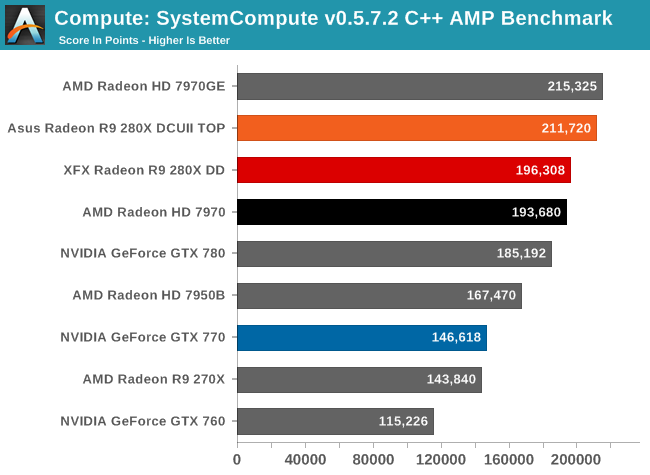
Although not by any means a blowout, yet again the 280X vies for the top here. When it comes to compute, the Tahiti based 280X is generally unopposed by anything in its price range.










151 Comments
View All Comments
AmdInside - Tuesday, October 8, 2013 - link
I still say its rebadge. The NVIDIA G92 went from 65nm to 55nm and lost analog TV out so by your definition G92 is not rebadged.Jumangi - Tuesday, October 8, 2013 - link
Yea that makes these totally different...ninjaquick - Tuesday, October 8, 2013 - link
What core difference exists between the 290X and the 280X? None really. The next gen's 370 is going to be a die-shrunk 280, and the 460 of the gen after that will be the same 7970 again. AMD is not going to bother releasing a new core design until the GCN is no longer apt for the task, which will only occur if HLSL/GLSL are retired completely.Gigaplex - Tuesday, October 8, 2013 - link
TrueAudio, some GPGPU instructions from GCN 1.1 plus whatever the 290X introduces on top of that is basically the core difference between 290X and 280X.Cellar Door - Tuesday, October 8, 2013 - link
I was looking forward to the R9 280X - simply because I hoped it would offer new features, revised silicon, maybe even new iteration of GCN. A REAL step forward - this is a let down. Because this hits my price point as I won't be able to afford their R9 290X, AMD was supposed to be a true champion of price - like always. It seems like I have no choice but to go with the green camp.silverblue - Tuesday, October 8, 2013 - link
Wait a minute... it trails the 770 on average by only a small amount and retails for $100 less. Sure, there's no game bundle, but how is this fleecing anybody?just4U - Tuesday, October 8, 2013 - link
One would think (since it's still pre-order status) that it's done in co-operation with their partners to help get rid of excess stock on the 7x line.. so Never settle bundles won't be offered until after all that is nearly gone. I suspect that such bundles will start being offered on the new line just as the holiday season starts.ltcommanderdata - Tuesday, October 8, 2013 - link
https://twitter.com/ID_AA_Carmack/status/386899206..."9x draw calls is credible over stock D3D, but Nvidia OpenGL extensions can give similar I mprocements."
In regards to Mantle, do you have any comment about John Carmack's report that AMD's claim of Mantle providing 9x more draw calls is already achievable by nVidia using their OpenGL extensions? Console porting is still an unique feature of Mantle, but on the draw call issue, if DirectX is slow to improve on this, then maybe AMD, Intel, and nVidia coming up with cross-vendor OpenGL extensions to address the issue may be a better solution than Mantle, especially given it converges with increased interest in OpenGL with SteamOS.
Pantsu - Tuesday, October 8, 2013 - link
AMD has made a similar statement. The new OpenGL extensions will bring similar improvements to what they advertise with Mantle, and that in the end the API will not be the bottleneck. As long as it's not Direct3D it seems. :D Perhaps even MS will eventually improve their game sooner or later.ananduser - Tuesday, October 8, 2013 - link
Have you not read Ryan's hunches on Mantle? Mantle is, or derived from, MS' low level Xbox API.